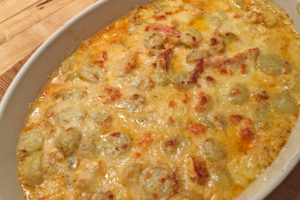Braised Duck Legs in Red Wine make a relatively easy-to-prepare dish for an elegant dinner. The meat becomes so tender it nearly falls off the bone.
An overnight dry marinade is essential to tenderize and enhance the flavor of the duck. The marinade of choice here is herbes de Provence. Because commercial herbes de Provence often does not include the essential ingredients, I make my own using equal amounts of dried thyme, rosemary, savory, fennel seed, lavender, and tarragon. If you use a commercial version, be certain it has fennel seed, which is the most prominent flavor for this dish. The lavender also gives the duck a distinctive flavor.
Pound the herbs together with some salt and pepper in a mortar and pestle or with a rolling pin.

Crush the herbs.
This not only makes the herbs finer, but also brings out their flavor more fully. Dry the duck legs with paper towels, and rub the herb mixture into each leg.

Rub the herbs into the duck legs.
Cover with foil and let marinate overnight in the refrigerator. Remove the duck legs from the refrigerator an hour or two before you are ready to cook them, bringing them to room temperature.
Preheat the oven to 375°. Place the legs skin-side up in a deep baking pan that can also be placed on the flame. The pan should be just large enough to hold the legs in one layer.

Roast in a deep pan.
Roast for 1 hour. You’ll love the smell of this as it roasts. Turn the legs skin-side down and roast another 10-20 minutes until the top skin is nicely browned.

Brown the top skin.

The browned top skin.
Pour off all the duck fat. This fat is wisely saved and refrigerated for future use.
While the duck is roasting, mince a large shallot.

Mince the shallot.
Heat a little olive oil in another pan. Cook the shallot until golden.

Cook the shallot.
Add a combination of 4 cups each of chicken and beef stocks, the bay leaf, and the thyme sprigs. Bring to a boil and reduce to about 5-6 cups.
If you have the time and the ingredients on hand, you can bring the sauce to a higher and richer level by browning some chicken scraps (backs, necks, giblets) in a bit of oil with a chopped carrots and sliced onion. Then discard the oil and simmer your stocks for a couple hours with the browned chicken parts and vegetables, adding a chopped celery rib, a bay leaf, and some thyme sprigs. Strain the broth, then proceed with the shallot and reduction method in the preceding step. I always maintain that the quality of your sauce is dependent on the quality of the stock you use.
Heat the wine in another saucepan to the simmer.
Turn the duck legs skin-side up. Pour the wine and 2 cups of the stock over the roasted duck legs. There should be enough liquid so that the meat is submerged, but the skin should be exposed. Roast another 45 minutes to an hour until the meat is very tender.

The duck cooked in the red wine.
Remove the legs from the pan and keep warm.
Pour the remaining reduced stock into the roasting pan, and bring the liquid to a boil on top of the stove and reduce it a bit more. Remove a few tablespoons of the liquid into a cup and dissolve a teaspoon or more of arrowroot in it. Stir the arrowroot mixture into the boiling liquid, and continue cooking until slightly thickened. The sauce should not be thick, but just have a slight liaison to it.

Add stock to the roasting pan.
Strain the sauce through a sieve into another pan, continuing to heat it. Taste for salt and pepper.
VARIATION WITH FRUIT: Once when making Braised Duck Legs in Red Wine, I discovered I had some leftover homemade plum sauce, which I had served with a baked ham. I added this to the sauce above with very favorable results. You can try this with sweetened dried cherries, pomegranate seeds, or even some orange marmalade. Duck goes extremely well with a fruit-laced sauce.
Arrange the Braised Duck Legs in Red Wine on a bed of mesclun or small greens on serving plates, and ladle a generous portion of sauce over each leg and greens. Serve any extra sauce on the side. You’ll also want to serve some crusty bread so your guests can mop up the delicious sauce. I like to accompany this dish with wild rice or a barley pilaf (recipe here).




